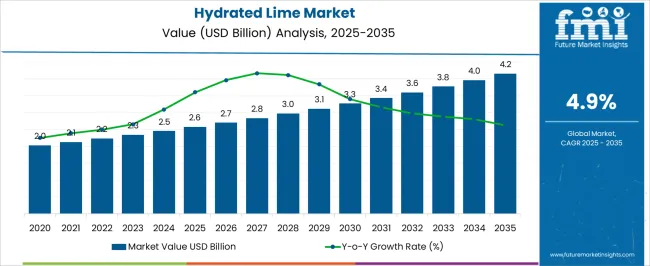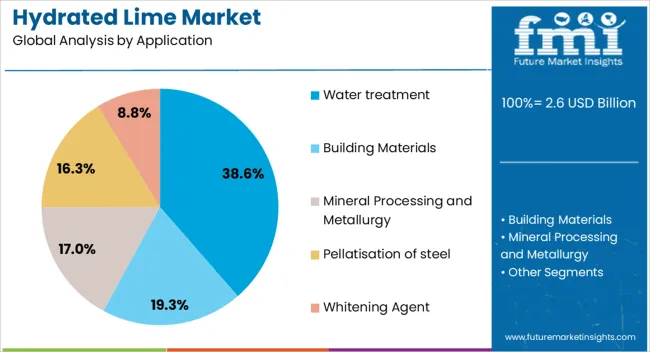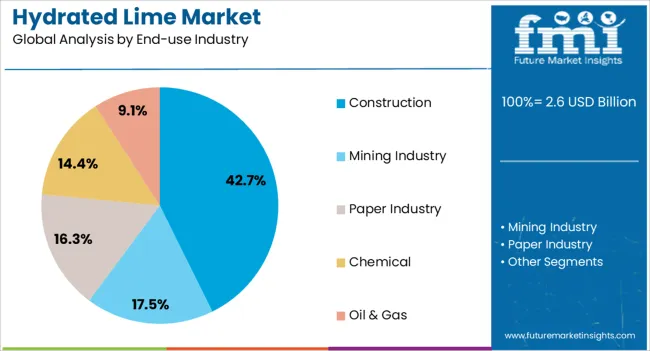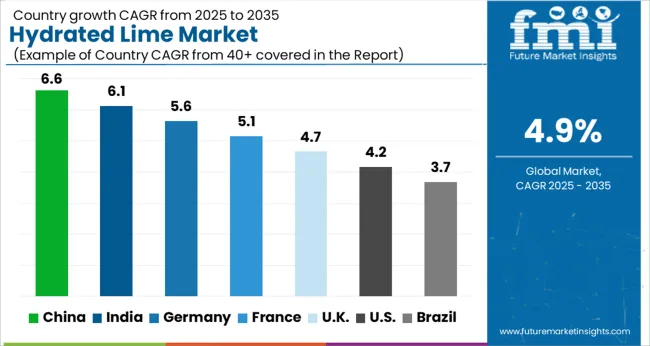The Hydrated Lime Market is estimated to be valued at USD 2.6 billion in 2025 and is projected to reach USD 4.2 billion by 2035, registering a compound annual growth rate (CAGR) of 4.9% over the forecast period.

| Metric | Value |
|---|---|
| Hydrated Lime Market Estimated Value in (2025 E) | USD 2.6 billion |
| Hydrated Lime Market Forecast Value in (2035 F) | USD 4.2 billion |
| Forecast CAGR (2025 to 2035) | 4.9% |
The Hydrated Lime market is experiencing robust growth, driven by its essential role in water treatment and construction applications. The current market scenario reflects strong adoption across industries where purification, pH control, and chemical stabilization are critical. Increasing urbanization, infrastructure development, and industrial expansion are creating sustained demand for high-quality hydrated lime.
Its versatility as a neutralizing agent in water treatment and as a binder and stabilizer in construction projects has reinforced its strategic importance. Market expansion is further supported by rising investments in municipal water treatment facilities, environmental regulations, and sustainable building practices that prioritize durable and environmentally friendly materials.
The ability to use hydrated lime for both treatment of drinking water and industrial wastewater, combined with its role in soil stabilization and concrete enhancement, has positioned the market for steady growth Looking forward, technological advancements in lime production and increased awareness of its multifaceted applications are expected to continue driving market adoption, particularly in regions with expanding urban infrastructure and industrial activity.
The hydrated lime market is segmented by application, end-use industry, and geographic regions. By application, hydrated lime market is divided into Water treatment, Building Materials, Mineral Processing and Metallurgy, Pellatisation of steel, and Whitening Agent. In terms of end-use industry, hydrated lime market is classified into Construction, Mining Industry, Paper Industry, Chemical, and Oil & Gas. Regionally, the hydrated lime industry is classified into North America, Latin America, Western Europe, Eastern Europe, Balkan & Baltic Countries, Russia & Belarus, Central Asia, East Asia, South Asia & Pacific, and the Middle East & Africa.

The Water Treatment application segment is projected to hold 38.60% of the Hydrated Lime market revenue share in 2025, emerging as a leading application. This dominance is being driven by the widespread use of hydrated lime as a pH regulator, coagulating agent, and contaminant remover in municipal and industrial water treatment systems. Adoption has been accelerated due to increasing regulatory standards for safe drinking water and industrial effluent management, which require reliable chemical treatment processes.
The segment has benefited from the versatility of hydrated lime in treating both acidic water and wastewater containing heavy metals or suspended solids. Its cost-effectiveness, coupled with operational efficiency, has enabled its deployment across large-scale treatment facilities.
Future growth in this segment is expected as urban populations expand and the demand for clean and safe water continues to rise, while operators increasingly adopt sustainable and low-cost solutions to comply with environmental regulations The consistent performance and adaptability of hydrated lime have reinforced its market leadership in water treatment applications.

The Construction end-use industry segment is expected to account for 42.70% of the Hydrated Lime market revenue share in 2025, establishing it as the dominant end-use segment. This growth is being driven by the increasing use of hydrated lime as a binder, stabilizer, and additive in cement, mortar, and soil stabilization applications. Adoption has been supported by the expanding global construction industry, including residential, commercial, and infrastructure projects.
Hydrated lime improves workability, durability, and long-term strength of construction materials, making it a preferred choice among builders and contractors. Additionally, its ability to reduce water demand in concrete mixes and enhance the durability of masonry structures has further reinforced its adoption.
Regulatory emphasis on sustainable building practices and environmentally friendly materials has also accelerated its utilization Future opportunities in this segment are expected to be supported by ongoing urbanization, smart city initiatives, and growing infrastructure investments, which will continue to fuel demand for hydrated lime in construction applications globally.
Lime is calcium-containing inorganic compound, in which oxides and hydroxides are predominate. Primarily, lime has two different types such as hydrated lime and quicklime. Hydrated lime is available in dry powder form, is less caustic as compared to quicklime. It is produced by hydrating or adding water during the manufacturing process, also known as slaking. Hydrated lime is used in ground or pulverized form. In term of applications, hydrated lime is used in metallurgical operations for refining and extraction of metals from mineral ores; in agricultural fields as a soil conditioner for pH balancing; and in the manufacturing of cement, clinker, plasters and related additive materials for concrete. Further, hydrated lime is used as a softener in water-treatment processes.
Further, it is used as a reagent in flue gas treatment during the desulphurization process and as a chemical additive for the manufacturing of paper, glass and processed leather products
Mining activities involve the refining of mineral ores in pure metal form to generate sludge effluents, which are released in water sources. These water resources, require effective water treatment, which in turn creates lucrative growth opportunities for hydrated lime producers, owing to the application of hydrated lime as a reagent for effluent treatment processes.
Existing mandatory environment management rules enforced by governments for achieving zero hazardous material discharge in natural water resources are expected to be the prime factor supporting this growth.
Precipitate calcium carbonate (PCC), made by hydrated lime, is an innovative product, which finds a wide range of application in the production of paper, paint, plastic, rubber, ink, etc. PPc's ability to replace high-cost impact modifiers in polymers is, in turn, driving its consumption in plastic industries_ PVC plastisols, polysulfides, urethanes, and silicones.
Thus, the demand for precipitated calcium carbonate is positively impacting on the global hydrated lime market throughout the forecast period. The growing use of hydrated lime in various application, specifically in the agriculture, chemical, plastic, and mining industries are expected to drive the demand for the global hydrated lime market.
On the basis of geography, the global hydrated lime market can be segmented into nine key regions, namely, South East Asia Pacific, Latin America, Western Europe, Middle East & Africa, China, Japan, Eastern Europe, and India. With growing investments in the Latin America region in the construction sector, the market in the region is projected to witness significant traction. Further, an increase of coal mining and the production of coal in the Asian market are expected to subsequently drive the demand for hydrated lime at the regional level. Increasing demand for pesticides from the South East Asia Pacific region, the hydrated lime market is estimated to grow with a healthy growth rate.
Also, China and India are major consumers of hydrated lime. In term of steel production, Europe dominates the market (the region has 168.7 million metric tons production of steel in 2025), owing to that, the demand for hydrated lime in Europe will increase in next few years. Further, the hydrated lime market in developed economies like North America estimated to grow with a healthy growth rate during the forecast period.
The global hydrated lime market expected to be fragmented throughout the forecast period. Some of the market participants identified across the value chain of the global hydrated lime market include Graymont Limited, Lhoist, SIBELCO, NIKI Chemical industries, McGean-Rohco Inc., KIMTAS, CARMEUSE, Boral Limited, Omya Australia Pty Ltd. and United States Lime & Minerals, Inc., among others.
The research report presents a comprehensive assessment of the market and contains thoughtful insights, facts, historical data, and statistically supported and industry-validated market data. It also contains projections using a suitable set of assumptions and methodologies. The research report provides analysis and information according to market segments such as geographies, application, and industry.
The report is a compilation of first-hand information, qualitative and quantitative assessment by industry analysts, inputs from industry experts and industry participants across the value chain. The report provides in-depth analysis of parent market trends, macro-economic indicators and governing factors along with market attractiveness as per segments. The report also maps the qualitative impact of various market factors on market segments and geographies.

| Country | CAGR |
|---|---|
| China | 6.6% |
| India | 6.1% |
| Germany | 5.6% |
| France | 5.1% |
| UK | 4.7% |
| USA | 4.2% |
| Brazil | 3.7% |
The Hydrated Lime Market is expected to register a CAGR of 4.9% during the forecast period, exhibiting varied country level momentum. China leads with the highest CAGR of 6.6%, followed by India at 6.1%. Developed markets such as Germany, France, and the UK continue to expand steadily, while the USA is likely to grow at consistent rates. Brazil posts the lowest CAGR at 3.7%, yet still underscores a broadly positive trajectory for the global Hydrated Lime Market. In 2024, Germany held a dominant revenue in the Western Europe market and is expected to grow with a CAGR of 5.6%. The USA Hydrated Lime Market is estimated to be valued at USD 970.2 million in 2025 and is anticipated to reach a valuation of USD 1.5 billion by 2035. Sales are projected to rise at a CAGR of 4.2% over the forecast period between 2025 and 2035. While Japan and South Korea markets are estimated to be valued at USD 128.4 million and USD 80.4 million respectively in 2025.
| Item | Value |
|---|---|
| Quantitative Units | USD 2.6 Billion |
| Application | Water treatment, Building Materials, Mineral Processing and Metallurgy, Pellatisation of steel, and Whitening Agent |
| End-use Industry | Construction, Mining Industry, Paper Industry, Chemical, and Oil & Gas |
| Regions Covered | North America, Europe, Asia-Pacific, Latin America, Middle East & Africa |
| Country Covered | United States, Canada, Germany, France, United Kingdom, China, Japan, India, Brazil, South Africa |
| Key Companies Profiled | Graymont, Lhoist, USLM, Carmeuse, Mississippi Lime, Pete Lien & Sons, Unimin, Nordkalk, and Cape Lime (Pty) Ltd |
The global hydrated lime market is estimated to be valued at USD 2.6 billion in 2025.
The market size for the hydrated lime market is projected to reach USD 4.2 billion by 2035.
The hydrated lime market is expected to grow at a 4.9% CAGR between 2025 and 2035.
The key product types in hydrated lime market are water treatment, building materials, mineral processing and metallurgy, pellatisation of steel and whitening agent.
In terms of end-use industry, construction segment to command 42.7% share in the hydrated lime market in 2025.






Our Research Products

The "Full Research Suite" delivers actionable market intel, deep dives on markets or technologies, so clients act faster, cut risk, and unlock growth.

The Leaderboard benchmarks and ranks top vendors, classifying them as Established Leaders, Leading Challengers, or Disruptors & Challengers.

Locates where complements amplify value and substitutes erode it, forecasting net impact by horizon

We deliver granular, decision-grade intel: market sizing, 5-year forecasts, pricing, adoption, usage, revenue, and operational KPIs—plus competitor tracking, regulation, and value chains—across 60 countries broadly.

Spot the shifts before they hit your P&L. We track inflection points, adoption curves, pricing moves, and ecosystem plays to show where demand is heading, why it is changing, and what to do next across high-growth markets and disruptive tech

Real-time reads of user behavior. We track shifting priorities, perceptions of today’s and next-gen services, and provider experience, then pace how fast tech moves from trial to adoption, blending buyer, consumer, and channel inputs with social signals (#WhySwitch, #UX).

Partner with our analyst team to build a custom report designed around your business priorities. From analysing market trends to assessing competitors or crafting bespoke datasets, we tailor insights to your needs.
Supplier Intelligence
Discovery & Profiling
Capacity & Footprint
Performance & Risk
Compliance & Governance
Commercial Readiness
Who Supplies Whom
Scorecards & Shortlists
Playbooks & Docs
Category Intelligence
Definition & Scope
Demand & Use Cases
Cost Drivers
Market Structure
Supply Chain Map
Trade & Policy
Operating Norms
Deliverables
Buyer Intelligence
Account Basics
Spend & Scope
Procurement Model
Vendor Requirements
Terms & Policies
Entry Strategy
Pain Points & Triggers
Outputs
Pricing Analysis
Benchmarks
Trends
Should-Cost
Indexation
Landed Cost
Commercial Terms
Deliverables
Brand Analysis
Positioning & Value Prop
Share & Presence
Customer Evidence
Go-to-Market
Digital & Reputation
Compliance & Trust
KPIs & Gaps
Outputs
Full Research Suite comprises of:
Market outlook & trends analysis
Interviews & case studies
Strategic recommendations
Vendor profiles & capabilities analysis
5-year forecasts
8 regions and 60+ country-level data splits
Market segment data splits
12 months of continuous data updates
DELIVERED AS:
PDF EXCEL ONLINE
Lime Spreader Market Size and Share Forecast Outlook 2025 to 2035
Lime Seed Oils Market Size and Share Forecast Outlook 2025 to 2035
Alimentary Tract Implant Market Size and Share Forecast Outlook 2025 to 2035
Dehydrated Garlic Market Size and Share Forecast Outlook 2025 to 2035
Dehydrated Skin Product Market Forecast Outlook 2025 to 2035
Dehydrated Onions Market Analysis - Size, Share, and Forecast Outlook 2025 to 2035
Dehydrated Vegetable Market Analysis - Size, Share, and Forecast Outlook 2025 to 2035
Dehydrated Culture Media Market Analysis - Size, Share, and Forecast 2025 to 2035
Dehydrated Pet Food Market Insights – Premium Nutrition & Market Trends 2025 to 2035
Competitive Overview of Dehydrated Onions Market Share
Market Share Insights of Dehydrated Meat Products Providers
Dehydrated Meat Product Market Growth & Demand Forecast 2025-2035
Millimeter Wave Technology Market Size and Share Forecast Outlook 2025 to 2035
Millimeter Wave Sensors Market by Devices, Frequency Band, Application & Region Forecast till 2025 to 2035
U.S. Lime Market Trends & Forecast 2016-2026
UK Dehydrated Onions Market Report – Trends, Demand & Outlook 2025–2035
5G Millimeter Wave RF Transceiver Market Size and Share Forecast Outlook 2025 to 2035
USA Dehydrated Onions Market Insights – Size, Trends & Forecast 2025-2035
ASEAN Dehydrated Onions Market Trends – Size, Demand & Forecast 2025-2035
Korea Dehydrated Vegetable Market Analysis by Product Type, Form, Nature, End Use, Technology, Distribution Channel, and Region Through 2035

Thank you!
You will receive an email from our Business Development Manager. Please be sure to check your SPAM/JUNK folder too.
Chat With
MaRIA